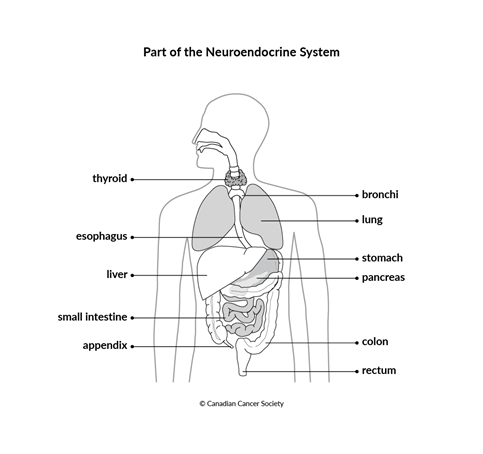The neuroendocrine system
The neuroendocrine system is made up of special cells called neuroendocrine cells.
They are spread throughout the body. Neuroendocrine cells are like nerve cells (
Where neuroendocrine cells are located
Neuroendocrine cells are found in almost every organ of the body. They are
mainly found scattered in the gastrointestinal (GI) tract (including the small
intestine, rectum, stomach, colon, esophagus and appendix), the gallbladder, the
pancreas (
The pituitary gland, the parathyroid glands and the inner layer of the adrenal gland (adrenal medulla) are almost all made up of neuroendocrine cells.
Other sites of neuroendocrine cells include the thymus, kidneys, liver, prostate, skin, cervix, ovaries and testicles.

What neuroendocrine cells do
Neuroendocrine cells make and release hormones and similar substances (peptides)
in response to
Neuroendocrine cells have many functions, which include controlling:
- the release of digestive enzymes to break down food
- how fast food moves through the GI tract
- air and blood flow through the lungs
- blood pressure and heart rate
- the amount of sugar (glucose) in the blood
- bone and muscle growth and development
The following are examples of hormones or peptides released by neuroendocrine cells and what they do.
- Serotonin (5-HT or 5-hydroxytryptamine) is a chemical released by nerve cells (neurotransmitter) that helps with digestion. A lot of the body’s serotonin is found and made in the neuroendocrine cells of the GI tract where it controls the movement of food through the GI tract.
- Gastrin tells the stomach to release acid and enzymes to help with digestion.
- Insulin is made by pancreatic islet cells. It lowers the level of sugar (glucose) in the blood when it’s high. It controls when cells absorb (take up) sugar for energy.
- Epinephrine (adrenaline) is made by neuroendocrine cells of the adrenal gland. It is released during times of stress, like when you feel fear, and increases heart rate and blood pressure.
- Growth hormone is made in the pituitary gland. It promotes the growth and development of bones and muscles.
Your trusted source for accurate cancer information
With just $5 from readers like you, we can continue to provide the highest quality cancer information for over 100 types of cancer.
We’re here to ensure easy access to accurate cancer information for you and the millions of people who visit this website every year. But we can’t do it alone.
If everyone reading this gave just $5, we could achieve our goal this month to fund reliable cancer information, compassionate support services and the most promising research. Please give today because every contribution counts. Thank you.
